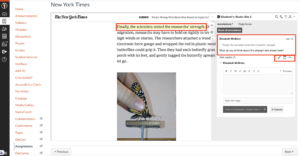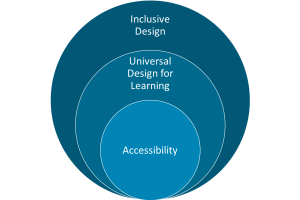
Background
Five years ago, I wrote a small entry in the ORTESOL Newsletter about the then state of “adaptive software capable of teaching, testing, giving feedback, and most importantly, adjusting to student needs” (Chambers, 2015: 13). I mentioned a set of technologies colloquially referred to as the “Digital Aristotle”, or ‘Project Halo’ (Friedland et al., 2004), and the update to this six years later (Gunning et al., 2010). The Digital Aristotle was described as ‘an application that will encompass much of the world’s scientific knowledge and be capable of applying sophisticated problem-solving to answer novel questions’ (Friedland et al., 2004).
At the time, I was writing about a more grandiose piece of software that might one day replace the repetitive tasks of an ESOL classroom. The idea, or perhaps the concern about this technology for existing teachers was where they would fit in once a set of algorithms could replicate much of the day to day learning of a language course.
Five years on, I turn to how learning designers might be able to incorporate AI into course design.
Potential
First, a question: is there currently a program capable of teaching a course and adapting to student needs like an instructor? The answer is still no. Certain technology has, however, progressed to the point that portions of an online course can be enhanced by AI.
Adaptive Learning
Quite possibly the most exciting development in artificial intelligence for learning is that of adaptive learning. This concept has been in the works for a while with certain platforms utilizing algorithms to produce content that adapt to specific learner needs.
Instructure’s Canvas for instance, allows Instructional Designers to set up ‘Differentiated Assignments’ (Canvas Doc Team, How do I view differentiated assignments with different due dates in a course?, 2017) and ‘MasteryPaths’ (Canvas Doc Team, How do I use MasteryPaths in course modules?, 2020) which ‘allows targeted learning activities to be assigned to different users and sections’ (‘MasteryPaths’). Currently this is a manual process with course designers creating every assessment beforehand. The best students might not see the additional activities. It is not ‘intelligent’ in the way that course content is adapted specifically for a learner’s needs and on the fly. To do this requires large amounts of data and most importantly, AI training to see patterns, strengths, and weaknesses for a particular learner.
This is why Duolingo records progress at every step and offers learners a review of concepts the learner struggles with in previous activities. Platforms that provide an automated review often use large question banks and flag questions that learners initially, or continuously incorrectly answer. An intelligent AI could create novel questions based on learner goals, data from prior students, and information about the subject matter. An example of this is Google or Amazon’s ability to predict and offer products or suggestions based on the vast amount of information provided to them every single day. Certain training providers are currently working with application developers to produce tools capable of this on-the-fly feedback and adaptation.
Discussions
At the OLC Innovate 2020 conference, Kasey Gandham from Ed Tech company Paperback and Kim A. Scalzo, Executive Director of Open SUN, demonstrated how Paperback’s AI is being used with online discussions to help students write higher quality posts. As students write their discussion posts, the AI program checks for “close-ended questions, plagiarism, insufficient length, content about class logistics, profanity and abuse’ (Gandham & Scalzo, 2020). After this, if required, the post is moderated and the learner receives email feedback saying why and how to revise their post. The AI is also capable of suggesting posts to feature as the best of the week by analyzing, among other things, sentence depth and ‘curiosity score’.
More than a Quiz
The role and importance of ‘big data’ in online learning cannot be understated. Technology already exists that records the time learners interact with learning materials. It knows where they are clicking/tapping on the screen and how long activities hold learner attention. Using this data, AI could suggest, or even craft assessments that are adapted specifically to a single learner’s usage habits. Traditional quizzes which assess information retention could become only part of the larger formative assessment of the entire course, at every point in the course, without the learner even realizing any of this is happening.
Future
AI-enhanced design has the ability to transform Instructional Designers like never before. It could help us to modify our own design practices based on how learners are responding to course content. Through learner feedback, it could demonstrate which activities are most appealing and conducive to personalized learning goals. Big data’s role in recording learner interactions with content can provide insights into preferred learning styles and methods of instruction. Instructional Designers will have to continue adapting with the technology just as we have done in our everyday lives.
References
Canvas Doc Team. (2017, April 19). How do I view differentiated assignments with different due dates in a course? Retrieved July 02, 2020, from https://community.canvaslms.com/docs/DOC-10036-how-do-i-view-differentiated-assignments-with-different-due-dates-in-a-course
Canvas Doc Team. (2020, April 6). How do I use MasteryPaths in course modules? Retrieved July 02, 2020, from https://community.canvaslms.com/docs/DOC-26231-how-do-i-use-masterypaths-in-course-modules
Chambers, P. (2015, Spring). “Digital Aristotle” and ESL: What does it mean for us?. ORTESOL Quarterly Newsletter, 38(1), P.12-13.
Friedland, N.S. et al. (2004). ‘Project Halo: Towards a Digital Aristotle’, American Association for Artificial Intelligence, 25(4), pp. 29-47. DOI: http:// dx.doi.org/10.1609/aimag.v25i4.1783.
Gandham, K. and Scalzo, K., A. (2020, June). USING AI IN DISCUSSION TO SCALE ACCESS TO QUALITY ONLINE EDUCATION. OLC Innovate 2020, Online Presentation. https://onlinelearningconsortium.org/olc-innovate-2020-session-page/?session=8486
Gunning, D. et al. (2010). ‘Project Halo Update – Progress Toward Digital Aristotle’, Association for the Advancement of Artificial Intelligence, 31(3), pp. 33-58. DOI: http:// dx.doi.org/10.1609/aimag.v31i3.2302.





 For DIY video production, there are many ways to go about this!
For DIY video production, there are many ways to go about this!



 Is blended learning right for your discipline or area of expertise? If you want to give it a try, there are many excellent internet resources available to support your transition.
Is blended learning right for your discipline or area of expertise? If you want to give it a try, there are many excellent internet resources available to support your transition.